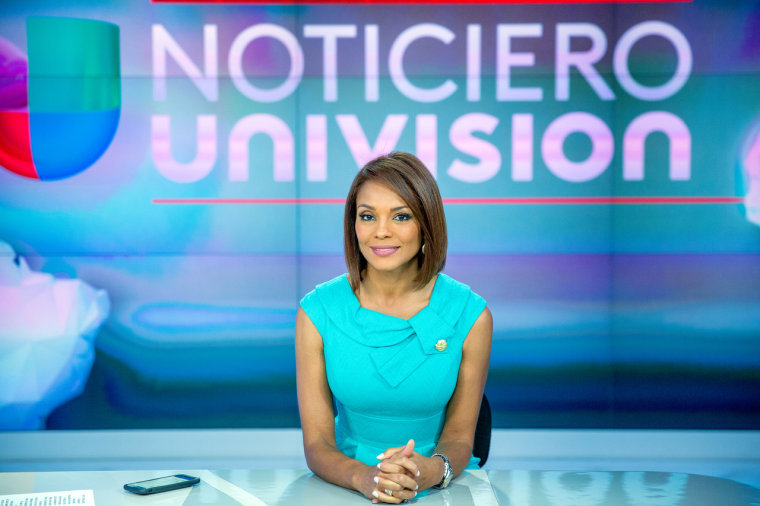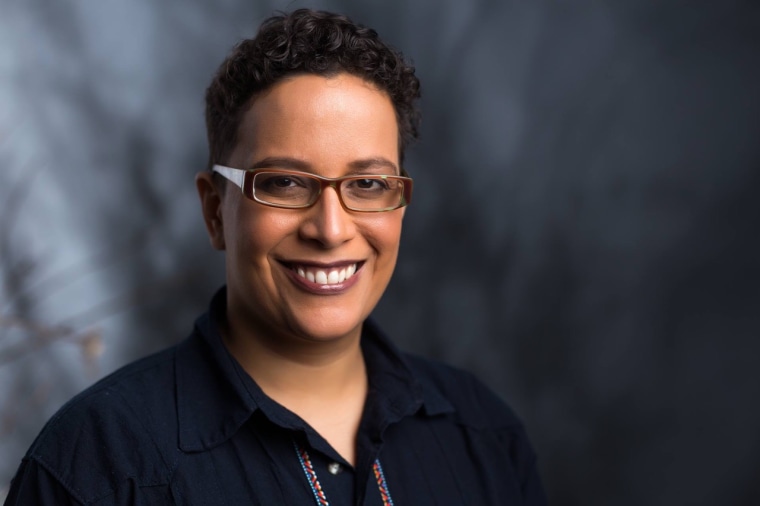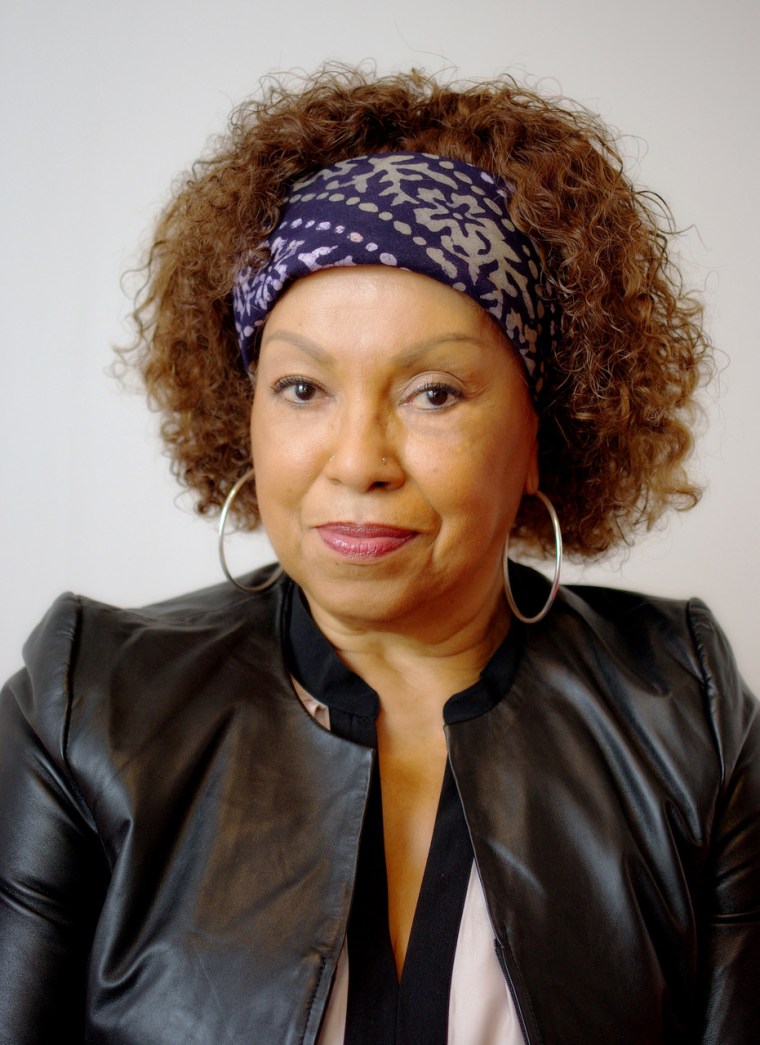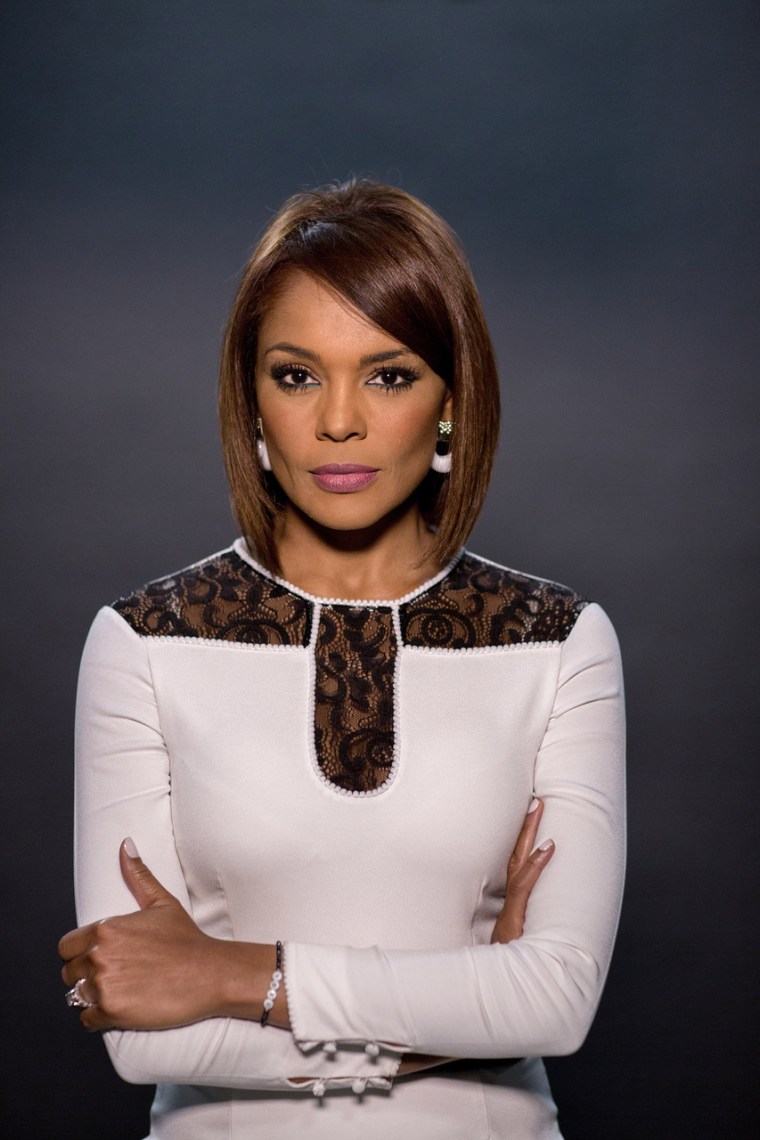Every weekday, Ilia Calderón goes to work, quietly making history as she reports the news alongside Jorge Ramos for Univision’s flagship Noticiero Univision. Since December, Calderón has been the first Afro-Latina to anchor the weekday evening news for a major broadcast network in the U.S.
While Calderón’s increased visibility may mark a turning point for Spanish-language media, some Afro-Latinos say there is still confusion, misunderstanding, and ignorance surrounding the nuances of their identity.
Calderón’s promotion generated headlines, because she was breaking a barrier in Spanish-language TV, and because she was replacing longtime anchor Maria Elena Salinas.
The Emmy award-winning Calderón told NBC News that the audience seems to have accepted her.
“It has been amazing, not only with the ratings but on social media as well,” she said. “Everywhere, on the street, in the supermarket, the reaction has been positive.”
It helps, she said, that she is not an unfamiliar face to viewers. Calderón previously co-hosted another edition of Noticiero Univision as well as Primer Impacto; she first anchored the weekend national evening news for Noticiero Telemundo. “I am not a stranger to the audience.”

Calderón said that she never put limits on herself because of her skin color. Yet she acknowledged that the path for Afro-Latinos in broadcasting can be difficult.
“I’m not gonna lie, I think it is hard. We are a minority within a minority, so the representation is not there,” the Colombian-born anchor said. “However, Univision is showing other companies that Black Hispanics can be successful too, and hopefully the company sets an example for other companies, in the media and elsewhere."
Asked whether dark-skinned Latinos have a harder time succeeding in Spanish language media, Lori Montenegro, national correspondent for Noticiero Telemundo, told NBC News in an e-mail exchange, “The situation is not limited to the television industry. In general, it is harder for people of color to make headway, break barriers, and stigmas in almost every field. It is something that as a society we continue to struggle with," she said. "It is a conversation that still makes a lot of people uncomfortable.”
“I am just a person who happens to be dark-skinned,” Montenegro stated. She, Calderón and other Afro-Latinos have succeeded because executives and supervisors moved past the color of their skin and focused on their work, skill, and talent.
A 2016 Pew Research Center study found that Afro-Latinos are about a quarter of U.S. Hispanics. Yet these numbers have not translated into proportional representation on-air at Spanish language television stations. Similarly, when the Fusion channel (now rebranded as the website Splinter) premiered in 2013, then aimed at Latino Millennials, it was criticized for being too white.
“While Latinos come in all colors and all shades, there has been a tendency in news and entertainment (in Spanish-language media) to favor lighter shades,” said Veronica Villafañe, editor and publisher of Media Moves, which covers Latinos in the media industry. “Now there is an opportunity for more inclusiveness and awareness, and awareness paves the way for change.”
Villafañe hesitated to say whether Afro-Latinos experienced discrimination in broadcasting. In her view, one problem is that when viewers do not see people who look like them on television, they may assume there has been preferential treatment or bias – even though there are many factors that play into the selection of on-air talent.
As to Calderón’s future prospects, Villafañe offered, “I don’t know if her success will be attributed to the color of her skin; more likely, it will reflect on her abilities as a journalist and whether she connects with the audience.”
Beyond broadcasting, both Latin American and U.S. society sends conflicting messages about Afro-Latino identity and race, messages that can be internalized in complex ways. Pew reported that, when asked directly about their race, only 18 percent of Afro-Latinos identified as black. Higher percentages of Afro-Latinos identified themselves as white (39 percent) or as Hispanic (24 percent). Nine percent of Afro-Latinos identified as mixed-race.
For some experts, these seemingly paradoxical figures show that Afro-Latinos are still wrestling with acceptance from African-Americans, Latinos, and themselves.
This struggle exists both within the Latino community and within Latino homes, says Johanna Ferreira, a women’s lifestyle and Latinx identity journalist in New York City. “Latinos are conditioned to thinking that Spanish ancestry is better, that it is the preferential part of our DNA,” she said. “Whiter-looking Latinos are still perceived as more beautiful and desirable, those with fair skin, straight hair, and narrow noses. We are still not seeing enough Latinos with darker skin and fuller figures in the media; that is still the message sent to us.”
Ferreira said that Calderón’s success meant a lot to her. “I noticed her years ago on Univision, and immediately I stopped what I was doing and thought, wow, that is an anchor who looks like me. I’ve never seen that before.”
Ferreira cited singer Amara La Negra as a positive representation of Afro-Latinidad. “Then, on the other hand, we have Sammy Sosa, who has increasingly been sporting a lighter skin tone. He probably grew up in an environment where darker skin tones were frowned upon, and he is likely a victim of that social conditioning.”
Ferreira believes that Latinos’ attitudes can, and should, evolve when it comes to accepting Afro-Latinos. “Even among my older relatives, when I hear comments that are offensive, I do not let them go,” she said. “It is part of our responsibility to speak up when people are making comments about someone looking ordinario (which means ordinary, but it's also a term used to refer to lower-class people), even if it’s abuelita (grandma). I let it be known that it is not okay to speak like that.”
Other experts echoed Ferreira’s concerns.
“I think the particular challenge that Afro-Latinos face is that they are caught between three axis,” said Ana-Maurine Lara, author and assistant professor in anthropology at the University of Oregon, “the colorism that is present in the U.S. and in their home countries, the traditional racist ideologies in the U.S., and the longstanding stereotypes in Hollywood and the media about who is Latina and who can be Latino/a. Afro-Latinos are at the intersection of these three constructs.”

Lara pointed out that, for many Latinos the idea that “lighter/whiter is better, darker/blacker is not” still persists today, citing the common concept of pelo malo (“bad hair,” typically associated with natural, curly hair) as an example. “We get policed within our own families about our ability to pass into whiteness. There is also the concept of buena presencia (“good appearance”), which usually means light-skinned, ‘good hair,’ and for women, a very feminized look.”
Lara praised Calderón for what she termed, “the fact that she is putting her body on the line in different ways when she is standing in front of a camera.”
Calderón has not shied from venturing into controversial situations. Last year, in an interview with a KKK leader in North Carolina, Calderón was called the N-word, a “mongrel,” and directly threatened. The KKK leader told her she was the first black person “or whatever you want to call yourself” to step on his property in over 20 years.
In 2015 Univision host Rodner Figueroa was fired after he compared then-First Lady Michelle Obama to characters in the movie "Planet of the Apes. In response, Calderón wrote an open letter to her young daughter on Twitter, preparing her for the discrimination she would likely face growing up as a biracial child (Despite the furor caused by his racial slur, Figueroa, who as part of his apology stressed that his father was Afro-Latino, was hired by Telemundo’s popular Al Rojo Vivo program last year).

Prominent Latina scholar Marta Moreno Vega, founder of the Caribbean Cultural Center African Diaspora Institute, sees both the positive and the negative in current attitudes towards Afro-Latinos.
“Racism is alive and well within the Latino community,” she said, which she attributes in part to the fact that Afro-Latinos are largely excluded from textbooks that young people read. “Coupled with the media’s image of ‘pharmaceutical blondes,’ this mis-educates people and erases Afro-Latino identity.”
On the other hand, Moreno Vega added, “Having an dark-skinned TV anchor begins to open up the issue, begins to set up the questions that need to happen in our communities. Calderón’s positioning provides the opportunities for discussion at multiple levels, but she should not be the exception.”
For her part, Calderón is optimistic about increased opportunities for Afro-Latinos in broadcasting. “This is not about me,” she said. “This is about doors that can open for others… The most important thing would be for me to see others hired for what I am doing. I hope it happens for others, and I hope I am not the only one for long.”
Raul A. Reyes is an NBC Latino contributor. Follow him on Twitter at @RaulAReyes, and on Instagram at @raulareyes1.


